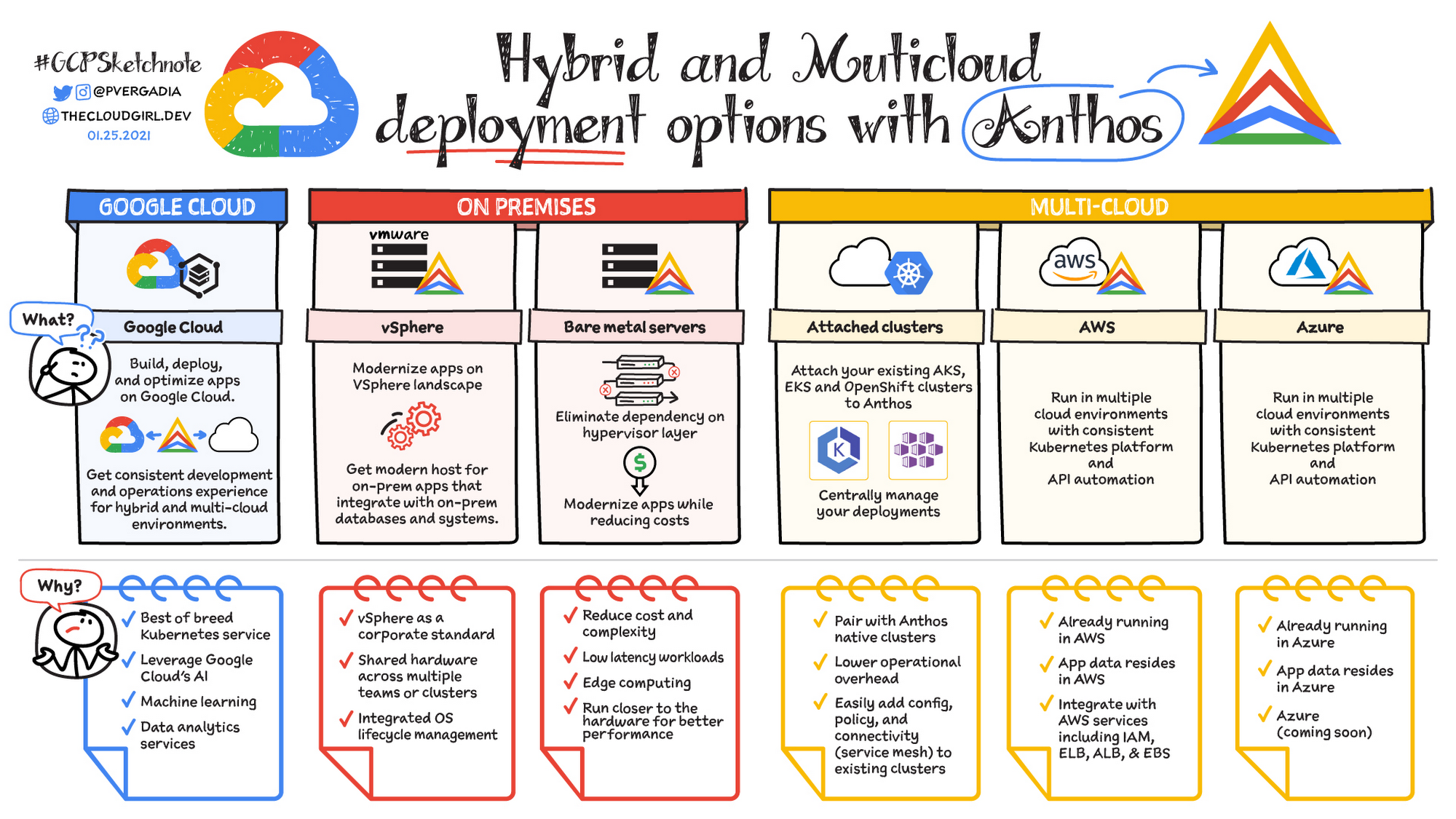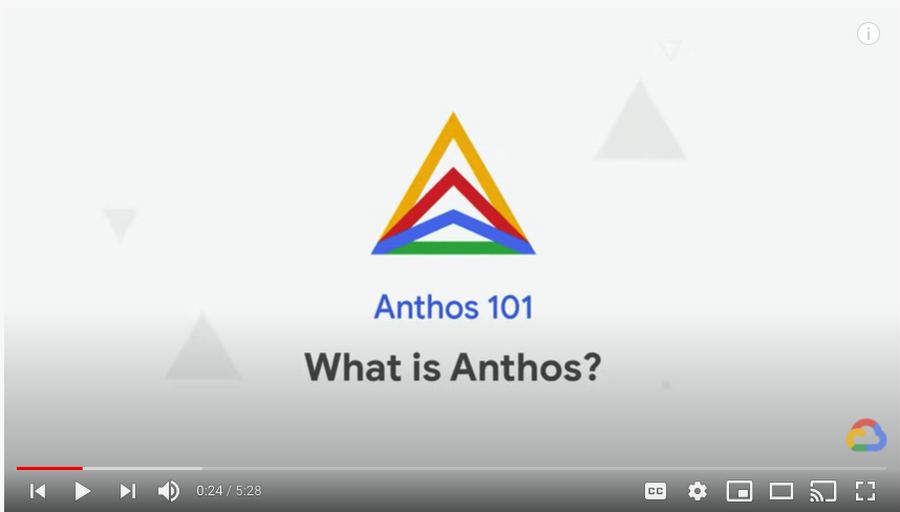What are my hybrid and multicloud deployment options with Anthos?

Arun Ananthampalayam
Product Manager
Priyanka Vergadia
Staff Developer Advocate, Google Cloud
Anthos is a managed application platform that extends Google Cloud services and engineering practices to your environments so you can modernize apps faster and establish operational consistency across them. With Anthos, you can build enterprise-grade containerized applications faster with managed Kubernetes on Google Cloud, on-premises, and other cloud providers. In this blog post, we outline each of Anthos deployment options:
- Google Cloud
- VMware vSphere
- Bare metal servers
- AWS
- Microsoft Azure
- Attached clusters


Deployment Option 1: Google Cloud
One way to improve your apps’ performance is to run your compute closer to your data. So, if you are already running your services on Google Cloud then it’s best to use Anthos to build, deploy, and optimize your containerized workloads directly on Google Cloud. You can take advantage of Google Cloud AI, machine learning, and data analytics services to gain critical business insights, improve decision-making, and accelerate innovation.
In this video, Tony Pujals walks you through a sample deployment for Anthos, including how to use the different tools that Anthos offers—such as Anthos Service Mesh and Anthos Config Management—to modernize, manage, and standardize your Kubernetes environments.
Deployment Option 2: VMware vSphere
If you are using VMware vSphere in your own environment then you can choose to run Anthos clusters on VMware, which enables you to create, manage, and upgrade Kubernetes clusters on your existing infrastructure. This is a good option if vSphere is a corporate standard for your organization and if you have shared hardware across multiple teams or clusters and with integrated OS lifecycle management.
With Anthos clusters on VMware, you can keep all your existing workloads on-premises without significant infrastructure updates. At the same time, you can modernize legacy applications by transforming them from VM-based to container-based using Migrate for Anthos. Going forward, you may decide to keep the newly updated, containerized apps on-prem or move them to the cloud. Either way, Anthos helps you to manage and modernize your apps with ease and at your own pace.
Deployment Option 3: Bare metal servers
Though virtual machines are unquestionably useful for a wide variety of workloads, a growing number of organizations are running Kubernetes on bare metal servers to take advantage of reduced complexity, cost, and hypervisor overhead. Anthos on bare metal lets you run Anthos on physical servers, deployed on an operating system provided by you, without a hypervisor layer. Anthos on bare metal comes with built-in networking, lifecycle management, diagnostics, health checks, logging, and monitoring.
Mission critical applications often demand the highest levels of performance and lowest latency from the compute, storage, and networking stack. By removing the latency introduced by the hypervisor layer, Anthos on bare metal lets you run computationally intensive applications such as GPU-based video processing, machine learning, and more, in a cost-effective manner.
Anthos on bare metal allows you to leverage existing investments in hardware, OS and networking infrastructure. The minimal system requirement to run Anthos on bare metal at the edge on resource-constrained hardware. This means that you can capitalize on all the benefits of Anthos—centralized management, increased flexibility, and developer agility—even for your most demanding applications.
Deployment Option 4: AWS
If your organization has more than a few teams, chances are pretty good that they’re using different technologies, and perhaps even different cloud platforms. Anthos is designed to abstract these details and provide you with a consistent application platform.
Anthos on AWS enables you to create Google Kubernetes-based clusters with all of the Anthos features you’d expect on Google Cloud. This means easy deployment using Kubernetes-native tooling, Anthos Config Management for policy and configuration enforcement, and Anthos Service Mesh for managing the increasing sprawl of microservices.
When you use the Google Cloud Console, you have a single pane of glass that you can use to manage your applications all in one place no matter where they are deployed.
Deployment Option 5: Microsoft Azure
We are always extending Anthos to support more kinds of workloads, in more kinds of environments, and in more locations. We announced last year that Anthos is coming to Azure. Support for Microsoft Azure is currently in preview, so stay tuned for more details!
Deployment Option 6: Anthos attached clusters
When thinking about deploying Anthos, you may be wondering about what you’ll do with your existing Kubernetes clusters. With Anthos attached clusters, you can retain your existing Kubernetes clusters while taking advantage of key Anthos features. Whether you're running Amazon EKS, Microsoft AKS, or Red Hat OpenShift, you can attach your existing clusters to Anthos. That means you can centrally manage your deployments in Google Cloud Console, enforce policies and configuration using Anthos Config Management, and centrally monitor and collect logs.
Of course, Anthos doesn't manage everything; you still must manually maintain your clusters and keep them up to date. This deployment option does, however, enable you to begin your Anthos journey at a pace that works well for you, and eases the transition to Anthos in other cloud environments.
Conclusion
So there you have it—six different hybrid and multicloud deployment options for Anthos! Depending on where your infrastructure and data is today, one or perhaps a combination of these options will help you power your application modernization journey, with a modern application platform that just works on-prem or in a public cloud, ties in seamlessly with legacy data center infrastructure, enables platform teams to cost-optimize, and supports a modern security posture anywhere.
Here is a comprehensive video series on Anthos that walks you through how to get started:

What is Anthos?
For more resources on Anthos checkout the Consistent service delivery everywhere with Anthos eBook, and join our upcoming webinar on Feb 18th.
And, for more #GCPSketchnote and similar cloud content follow me on twitter @pvergadia and keep an eye out on thecloudgirl.dev.




